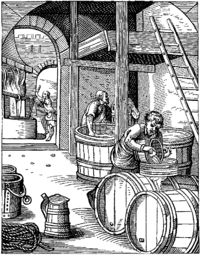
Photo from wikipedia
The perception of hop-derived flavour in beer is not well understood, particularly regarding the effect that different yeast strains and fermentation parameters have on perceived hop aroma and the mechanisms… Click to show full abstract
The perception of hop-derived flavour in beer is not well understood, particularly regarding the effect that different yeast strains and fermentation parameters have on perceived hop aroma and the mechanisms responsible for these changes. To evaluate the influence of yeast strain on the sensory properties and volatile composition of beer, a standard wort, late-hopped with New Zealand Motueka hops (5 g·L−1), was fermented with one of twelve yeast strains under constant conditions (temperature and yeast inoculation rate). The bottled beers were evaluated using a free sorting sensory methodology, and their volatile organic compounds (VOC) were assessed using gas chromatography mass spectrometry (GC/MS) with headspace solid-phase microextraction (SPME) sampling. Beer fermented with SafLager W-34/70 yeast was associated with a hoppy flavour attribute, whereas WY1272 and OTA79 beers were sulfury, and WY1272 was also metallic. WB06 and WLP730 beers were perceived to be spicy, with WB06 beer also perceived as estery, whereas VIN13 beer was sour, and the WLP001 beer was astringent. Beers fermented using the twelve yeast strains had clearly distinct VOC profiles. Beer made with WLP730, OTA29, SPH, and WB06 yeasts had the highest 4-vinylguaiacol levels, which contributed to their spicy attribute. Beer made with W3470 had high levels of nerol, geraniol, and citronellol, which supported its sensory characterisation as being ‘hoppy’. This research has illustrated the important role that yeast strain has on modulating hop flavour in beer.
Journal Title: Foods
Year Published: 2023
Link to full text (if available)
Share on Social Media: Sign Up to like & get
recommendations!